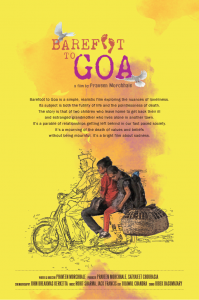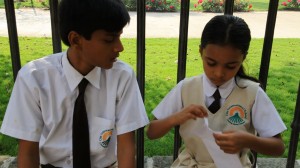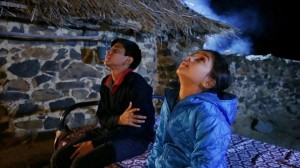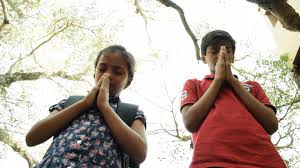 Barefoot to Goa (Director. Praveen Morchhale) is an exploration of family.
Barefoot to Goa (Director. Praveen Morchhale) is an exploration of family.
The above sentence may sound simple and clichéd even, but as this film conveys, the subject is far from simple and portrays the impossibility of families fitting into what may seem, the neat borders of cliché.
A brother and sister being brought up in bustling Mumbai decide to set out on the search for their Grandmother. Part of a normal nuclear family- an aloof nuclear family- the young siblings, Prakhar aged 11 and Diya aged 9, crave to know their estranged Grandmother who lives miles away in Goa. One day, the duo stumbles across a box of unopened letters hidden away by their mother. They then decide to run away from home and travel alone from Mumbai to Goa in order to bring their Grandmother home. Through the film, the question is provoked: what does it take to be courageous?
Is courage in the unconditional love of the Grandmother or the love-less children brought up in Mumbai who shine with innocence? Innocence and faith play a huge role in the film as both the Grandmother and Grandchildren depict this: something that the parents have chosen to discard perhaps.
An immediate strength of the film is the direction, the dialogue and the symbolism. The director has excellently directed the characters to push certain buttons and strike up emotion. Whether it is through the confused guilt in the father’s eyes for shunning his elderly mother miles away in Goa, or at the moment where he unsuccessfully argues to bring her home with his dominant wife, the father becomes a robotic member of the family, simply providing the material needs.
 It became clear that this film is about woman power: the Grandmother (Farrukh Jaffar), the Mother (Purva Parag) and the fearless little girl, Diya (Saara Nahar). Whereas the mother dominates her husband (Kuldeep Singh), the little girl convinces her brother Prakhar (Prakhar Morchhale) to set out on the search.
It became clear that this film is about woman power: the Grandmother (Farrukh Jaffar), the Mother (Purva Parag) and the fearless little girl, Diya (Saara Nahar). Whereas the mother dominates her husband (Kuldeep Singh), the little girl convinces her brother Prakhar (Prakhar Morchhale) to set out on the search.
What is unique about Barefoot to Goa is how the film immediately makes the audience step into the shoes of the “catalyst” character, Grandmother. Why the term catalyst is appropriate is because the film is centred on this character despite her not having much screen time. Interestingly, she may seem vulnerable, she may seem “old”, she may seem lonely, however- she is the most powerful. Her power lies in her faith in unconditional love. Something that is perhaps an element we all crave. Symbolically she cannot speak or write and communicates through a letter writer. However, she holds a presence and can show her emotions- her pain and strength- crystal clearly than the “educated” Mumbai parents. This could suggest that words take away the power of emotion and “education” as we know it, is actually teaching people how not to communicate. The portrayal of the female characters breaks away from the patriarchal mould often set in stone as the pillar of strength and family. The power of the male perhaps becomes blurred to emphasise maternal energy as the real spark that literally feeds the soul.
 Speaking of feeding, food has a symbolic place within the film. The opening shot of the Grandmother making mithai to post to her grand children serves as her introduction as does the Mumbai mother’s introduction. Whereas the Grandmother cooks with devotion and love, the Mumbai mother is clearly feeding her family as a “chore”: food becomes a way of communicating love and symbolism for nourishing not just the body, but nourishing the soul.
Speaking of feeding, food has a symbolic place within the film. The opening shot of the Grandmother making mithai to post to her grand children serves as her introduction as does the Mumbai mother’s introduction. Whereas the Grandmother cooks with devotion and love, the Mumbai mother is clearly feeding her family as a “chore”: food becomes a way of communicating love and symbolism for nourishing not just the body, but nourishing the soul.
What may have made the film even more powerful is an insight into the Mumbai mother’s psyche. Why has she become aloof and cold? Why so disconnected from showing her children love? But perhaps, the distance is needed to highlight her removed character. She clearly cares, but the maternal spark diminishes until she is separated from her children. This provokes the question, does one need to lose what they have to understand the significance? But then, why doesn’t the Grandmother’s son bring home his mother? Does he not understand her unconditional love or does he choose not to as this may emphasize the lack in his life? This is echoed through his own aloofness to his children. Significantly, he is physically removed from the family to provide for them. I felt that this suggests how the contemporary world encourages chasing materialism and that “success” is labelled as managing to provide for a family. Or perhaps, the world is such a struggle that connecting with others, especially loved ones is buried away as a secondary necessity- the initial being protecting a family financially.
 As the saying goes, money certainly can’t buy love. The young boy’s expensive looking polo T Shirt, as he travels with his sister across India, creates a powerful contrast to the “poorer” persons they encounter. It is symbolic that the young children leave the comforts of home to encounter their adventure and set out for what they truly want: the love and beacon of hope that their Grandmother symbolises.
As the saying goes, money certainly can’t buy love. The young boy’s expensive looking polo T Shirt, as he travels with his sister across India, creates a powerful contrast to the “poorer” persons they encounter. It is symbolic that the young children leave the comforts of home to encounter their adventure and set out for what they truly want: the love and beacon of hope that their Grandmother symbolises.
In terms of cinematography, the choppy camera work following the Grandmother down the streets in the opening scene and of the children on the scooter, en route to Goa, give this film a universal and human element: the audience are taken on this journey “physically” with the characters. The sepia coloured “dream” sequences emphasise being removed from reality. Although these scenes are “colourless”, so to speak, it is these scenes that bring life and colour to the ambition of finding love, of finding Grandmother.
 At the end credits of Barefoot to Goa, there was pin drop silence. The ending although powerful, lacked an element of closure- indeed a strength as well as a weakness. This is not so much because of the direction, but because of the message. However, I really wanted to know more on how the Grandmother’s son. Further exploration of this character would have added an extra dimension and add to the puzzle. Nonetheless, the film encourages the audience to find the missing piece independently.
At the end credits of Barefoot to Goa, there was pin drop silence. The ending although powerful, lacked an element of closure- indeed a strength as well as a weakness. This is not so much because of the direction, but because of the message. However, I really wanted to know more on how the Grandmother’s son. Further exploration of this character would have added an extra dimension and add to the puzzle. Nonetheless, the film encourages the audience to find the missing piece independently.
Barefoot to Goa explores what it takes to communicate love, what it takes to nourish courage. The film asks, what are we all actually looking for? This film will remind you to be cautious on what you decide to chase, as the chase will become you.









